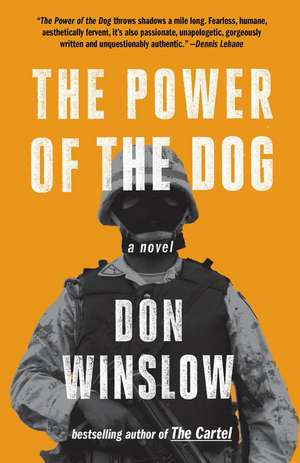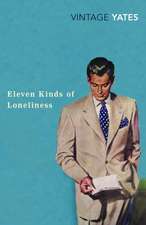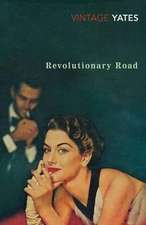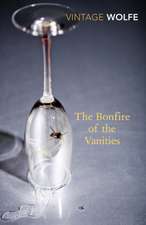The Power of the Dog: Power of the Dog Series
Autor Don Winslowen Limba Engleză Paperback – 30 apr 2006
Vezi toate premiile Carte premiată
Dilys Award (2006), Macavity Award (2006)
An explosive novel of the drug trade, The Power of the Dog, takes you deep inside a world riddled with corruption, betrayal, and bloody revenge.
Art Montana is an obsessive DEA agent. The Barrera brothers are heirs to a drug empire. Nora Hayden is a jaded teenager who becomes a high-class hooker. Father Parada is a powerful and uncorruptable Catholic priest. Callan is an Irish kid from Hell’s kitchen who grows up to be a merciless hitman. And they are all trapped in the world of the Mexican drug Federación. From the streets of New York City to Mexico City and Tiajuana to the jungles of Central America, this is the war on drugs like you’ve never seen it.
| Toate formatele și edițiile | Preț | Express |
|---|---|---|
| Paperback (2) | 56.61 lei 24-30 zile | +24.88 lei 4-10 zile |
| Random House – 27 apr 2006 | 56.61 lei 24-30 zile | +24.88 lei 4-10 zile |
| Vintage Books USA – 30 apr 2006 | 124.10 lei 17-23 zile | +10.75 lei 4-10 zile |
Preț: 124.10 lei
Nou
Puncte Express: 186
Preț estimativ în valută:
23.75€ • 25.81$ • 19.97£
23.75€ • 25.81$ • 19.97£
Carte disponibilă
Livrare economică 27 martie-02 aprilie
Livrare express 14-20 martie pentru 20.74 lei
Preluare comenzi: 021 569.72.76
Specificații
ISBN-13: 9781400096930
ISBN-10: 1400096936
Pagini: 539
Dimensiuni: 134 x 203 x 25 mm
Greutate: 0.39 kg
Editura: Vintage Books USA
Colecția Vintage Books
Seria Power of the Dog Series
ISBN-10: 1400096936
Pagini: 539
Dimensiuni: 134 x 203 x 25 mm
Greutate: 0.39 kg
Editura: Vintage Books USA
Colecția Vintage Books
Seria Power of the Dog Series
Recenzii
"An express train of a thriller that cannot be put down. . . . One of this year's finest novels." —The Baltimore Sun“A pit bull of a book. Once unleashed, this thriller . . . charges and attacks without mercy, shredding anyone in its path. . . . A well-tuned plot, driving rhythm, intelligence and a touch of politics. . . . A page turner.” —The Washington Post“Powerful. . . . A heartbreaking chronicle of the drug wars between the U.S. and Mexico, which is biblical in its dramatic scope and in the classic beauty of its prose rumbling in the background like heavenly thunder.” —The Chicago Tribune “A rippingly good thriller. . . . It fumes, it smokes, it burns; it soars, it pitches, it cascades along.” —The Dallas Morning News“The war on drugs is powerfully dramatized in Winslow’s ambitious, dense and gritty latest . . . Winslow’s depth of research and unflagging attention to detail give the story both heft and immediacy, and his staccato, present-tense prose shifts easily among wildly disparate settings and multiple points of view. A complex plot, well-drawn characters and plenty of double-crossing make this a thinking person’s narco-thriller.”—Publishers Weekly“This book comes at you like a champion boxer, deft and probing, and bristling with menace. Aiming for both the head and the gut, it connects solidly with every punch.”—Dan Fesperman, author of The Warlord’s Son“The Power of the Dog is the most compelling crime novel I’ve read in several years. It’s sharply written, vertiginously fast, and best of all it’s about something. In the unholy trinity of narcotics, dollars and politics Winslow has located our heart of darkness. This is a spectacular novel, disturbing and unforgettable.”—T. Jefferson Parker, author of California Girl“With an epic’s scope and a freight train’s rush, The Power of the Dog is an absolute page-turner. I couldn’t put it down and I was sorry when it ended. As always, Don Winslow delivers!”—S.J. Rozan, author of Absent Friends “From the heart-wrenching very first sentence I was hooked. A soaring, blazing saga of the real drug world, it is masterly, moving, and compassionate: an instant classic. It’s been a long wait since Winslow’s wondrous California Fire and Life. Was it worth the wait? Was it ever, and then some.”—Ken Bruen, author of The Killing of the Tinkers “Don Winslow’s The Power of the Dog is a great read. Intricate, powerful, and fierce, it takes the reader into the moral labyrinth of the international drug trade and the men who lose their souls along the way. Winslow’s knowledge and insight have never been more fully realized. I believed every word of it.”—Robert Ferrigno, author of The Wake-Up “The Power of the Dog is a steaming cauldron of crime, corruption, and cabals, an epic of Godfather proportions with just enough fact sprinkled into the stew to make this one fabulous fable.”—Andrew Vachss, author of Down Here “The Power of the Dog is the first great dope novel since Dog Soldiers thirty years ago. It’s frightening and sad, with a superbly sustained intensity. It’s a beautifully compressed vision of hell, with all its attendant moral madness.”—James Ellroy, author of The Cold Six Thousand
Notă biografică
Don Winslow has worked as a private investigator in London, New York City, and elsewhere in the United States, and as a consultant to law firms and insurance companies for more than fifteen years.
Extras
Badiraguato District
State of Sinaloa
Mexico
1975
The poppies burn.
Red blossoms, red flames.
Only in hell, Art Keller thinks, do flowers bloom fire.
Art sits on a ridge above the burning valley. Looking down is like peering into a steaming soup bowl—he can’t see clearly through the smoke, but what he can make out is a scene from hell.
Hieronymus Bosch does the War on Drugs.
Campesinos—Mexican peasant farmers—trot in front of the flames, clutching the few possessions they could grab before the soldiers put the torch to their village. Pushing their children in front of them, the campesinos carry sacks of food, family photographs bought at great price, some blankets, some clothes. Their white shirts and straw hats—stained yellow with sweat—make them ghost-like in the haze of smoke.
Except for the clothes, Art thinks, it could be Vietnam.
He’s half-surprised, glancing at the sleeve of his own shirt, to see blue denim instead of army green. Reminds himself that this isn’t Operation Phoenix but Operation Condor, and these aren’t the bamboo-thick mountains of I Corps, but the poppy-rich mountain valleys of Sinaloa.
And the crop isn’t rice, it’s opium.
Art hears the dull bass whop-whop-whop of helicopter rotors and looks up. Like a lot of guys who were in Vietnam, he finds the sound evocative. Yeah, but evocative of what? he asks himself, then decides that some memories are better left buried.
Choppers and fixed-wing planes circle overhead like vultures. The airplanes do the actual spraying; the choppers are there to help protect the planes from the sporadic AK-47 rounds fired by the remaining gomeros—opium growers—who still want to make a fight of it. Art knows too well that an accurate burst from an AK can bring down a chopper. Hit it in the tail rotor and it will spiral down like a broken toy at a kid’s birthday party. Hit the pilot, and, well . . . So far they’ve been lucky and no choppers have been hit. Either the gomeros are just bad shots, or they’re not used to firing on helicopters.
Technically, all the aircraft are Mexican—officially, Condor is a Mexican show, a joint operation between the Ninth Army Corps and the State of Sinaloa—but the planes were bought and paid for by the DEA and are flown by DEA contract pilots, most of them former CIA employees from the old Southeast Asia crew. Now there’s a tasty irony, Keller thinks—Air America boys who once flew heroin for Thai warlords now spray defoliants on Mexican opium.
The DEA wanted to use Agent Orange, but the Mexicans had balked at that. So instead they are using a new compound, 24-D, which the Mexicans feel comfortable with, mostly, Keller chuckles, because the gomeros were already using it to kill the weeds around the poppy fields.
So there was a ready supply.
Yeah, Art thinks, it’s a Mexican operation. We Americans are just down here as “advisers.”
Like Vietnam.
Just with different ball caps.
The American War on Drugs has opened a front in Mexico. Now ten thousand Mexican army troops are pushing through this valley near the town of Badiraguato, assisting squadrons of the Municipal Judicial Federal Police, better known as the federales, and a dozen or so DEA advisers like Art. Most of the soldiers are on foot; others are on horseback, like vaqueros driving cattle in front of them. Their orders are simple: Poison the poppy fields and burn the remnants, scatter the gomeros like dry leaves in a hurricane. Destroy the source of heroin here in the Sinaloan mountains of western Mexico.
The Sierra Occidental has the best combination of altitude, rainfall and soil acidity in the Western Hemisphere to grow Papaver somniferum, the poppy that produces the opium that is eventually converted to Mexican Mud, the cheap, brown, potent heroin that has been flooding the streets of American cities.
Operation Condor, Art thinks.
There hasn’t been an actual condor seen in Mexican skies in over sixty years, longer in the States. But every operation has to have a name or we don’t believe it’s real, so Condor it is.
Art’s done a little reading on the bird. It is (was) the largest bird of prey, although the term is a little misleading, as it preferred scavenging over hunting. A big condor, Art learned, could take out a small deer; but what it really liked was when something else killed the deer first so the bird could just swoop down and take it.
We prey on the dead.
Operation Condor.
Another Vietnam flashback.
Death from the Sky.
And here I am, crouched in the brush again, shivering in the damp mountain cold again, setting up ambushes.
Again.
Except the target now isn’t some VC cadre on his way back to his village, but old Don Pedro Áviles, the drug lord of Sinaloa, El Patrón himself. Don Pedro’s been running opium out of these mountains for half a century, even before Bugsy Siegel himself came here, with Virginia Hill in tow, to nail down a steady source of heroin for the West Coast Mafia.
Siegel made the deal with a young Don Pedro Áviles, who used that leverage to make himself patrón, the boss, a status he’s maintained to this day. But the old man’s power has been slipping a little lately as some young up-and-comers have started to challenge his authority. The law of nature, Art supposes—the young lions eventually take on the old. Art has been kept awake more than one night in his Culiacán hotel room by the sound of machine-gun fire in the streets, so common lately that the city has gained the nickname Little Chicago.
Well, after today, maybe they won’t have anything to fight about.
Arrest old Don Pedro and you put an end to it.
And make yourself a star, he thinks, feeling a little guilty.
Art is a true believer in the War on Drugs. Growing up in San Diego’s Barrio Logan, he saw firsthand what heroin does to a neighborhood, particularly a poor one. So this is supposed to be about getting drugs off the streets, he reminds himself, not advancing your career.
But the truth of it is that being the guy to bring down old Don Pedro Áviles would make your career.
Which, truth be told, could use a boost.
The DEA is a new organization, barely three years old. When Richard Nixon declared a War on Drugs, he needed soldiers to fight it. Most of the new recruits came from the old Bureau of Narcotics and Dangerous Drugs; a lot of them came from various police departments around the country, but not a few of the early start-up draft into the DEA came from the Company.
Art was one of these Company Cowboys.
That’s what the police types call any of the guys who came in from the CIA. There’s a lot of resentment and mistrust of the covert types by the law enforcement types.
Shouldn’t be, Art thinks. It’s basically the same function—intelligence gathering. You find your assets, cultivate them, run them and act on the intelligence they give you. The big difference between his new work and his old work is that in the former you arrest your targets, and in the latter you just kill them.
Operation Phoenix, the programmed assassination of the Vietcong infrastructure.
Art hadn’t done too much of the actual “wet work.” His job back in Vietnam was to collect raw data and analyze it. Other guys, mostly Special Forces on loan to the Company, went out and acted on Art’s information.
They usually went out at night, Art recalls. Sometimes they’d be gone for days, then reappear back at the base in the small hours of the morning, cranked up on Dexedrine. Then they’d disappear into their hooches and sleep for days at a time, then go out and do it again.
Art had gone out with them only a few times, when his sources had produced info about a large group of cadres concentrated in the area. Then he’d accompany the Special Forces guys to set up a night ambush.
He hadn’t liked it much. Most of the time he was scared shitless, but he did his job, he pulled the trigger, he took his buddies’ backs, he got out alive with all his limbs attached and his mind intact. He saw a lot of shit he wishes he could forget.
I just have to live with the fact, Art thinks, that I wrote men’s names down on paper and, in the act of doing so, signed their death warrants. After that, it’s a matter of finding a way to live decently in an indecent world.
But that fucking war.
That goddamn motherfucking war.
Like a lot of people, he watched the last helicopters taking off from Saigon rooftops on television. Like a lot of vets, he went out and got good and stinking drunk that night, and when the offer came to move over to the new DEA, he jumped at it.
He talked it over with Althie first.
“Maybe this is a war worth fighting,” he told his wife. “Maybe this is a war we can actually win.”
And now, Art thinks as he sits and waits for Don Pedro to show up, we might be close to doing it.
His legs ache from sitting still but he doesn’t move. His stint in Vietnam taught him that. The Mexicans spaced in the brush around him are likewise disciplined—twenty special agents from the DFS, armed with Uzis, dressed in camouflage.
Tío Barrera is wearing a suit.
Even up here in the high brush, the governor’s special assistant is wearing his trademark black suit, white button-down shirt, skinny black tie. He looks comfortable and serene, the image of Latino male dignity.
He reminds you of one of those matinee idols from an old ’40s movie, Art thinks. Black hair slicked back, pencil mustache, thin, handsome face with cheekbones that look like they’re cut from granite.
Eyes as black as a moonless night.
Officially, Miguel Ángel Barrera is a cop, a Sinaloa state policeman, the bodyguard to the state governor, Manuel Sánchez Cerro. Unofficially, Barrera is a fixer, the governor’s point man. And seeing how Condor is technically a Sinaloa state operation, Barrera is the guy who’s really running the show.
And me, Art thinks. If I really want to be honest about it, Tío Barrera is running me.
The twelve weeks of DEA training weren’t that hard. The PT was a breeze—Art could easily run the three-mile course and play basketball, and the self-defense component was unsophisticated compared with Langley. The instructors just had them wrestle and box, and Art had finished third in the San Diego Golden Gloves as a kid.
He was a mediocre middleweight with good technique but slow hands. He found out the hard truth that you can’t learn speed. He was just good enough to get into the upper ranks, where he could really get beat up. But he showed he could take it, and that was his ticket as a mixed-race kid in the barrio. Mexican fight fans have more respect for what a fighter can take than for what he can dish out.
And Art could take it.
After he started boxing, the Mexican kids pretty much left him alone. Even the gangs backed off him.
In the DEA training sessions he made it a point to take it easy on his opponents in the ring, though. There was no point in beating someone up and making an enemy just to show off.
The law enforcement–procedure classes were tougher, but he got through them all right, and the drug training was pretty easy, questions like, Can you identify marijuana? Can you identify heroin? Art resisted the impulse to answer that he always could at home.
The other temptation he resisted was to finish first in his class. He could have, knew he could have, but decided to fly under the radar. The law enforcement guys already felt that the Company types were trespassing on their turf, so it was better to walk lightly.
So he took it a little easy in the physical training, kept quiet in class, punted a few questions on the tests. He did enough to do well, to pass, but not enough to shine. It was a little harder to be cool in the field training. Surveillance practice? Old hat. Hidden cameras, mikes, bugs? He could install them in his sleep. Clandestine meetings, dead drops, live drops, cultivating a source, interrogating a suspect, gathering intelligence, analyzing data? He could have taught the course.
He kept his mouth shut, graduated, and was declared a Special Agent of the DEA. They gave him a two-week vacation and sent him straight to Mexico.
Right to Culiacán.
The capital of the Western Hemisphere drug trade.
Opium’s market town.
The belly of the beast.
His new boss gave him a friendly greeting. Tim Taylor, the Culiacán RAC (Resident Agent in Charge) had already perused Art’s shield and seen through the transparent screen. He didn’t even look up from the file. Art was sitting across from his desk and the guy said, “Vietnam?”
“Yup.”
“ ‘Accelerated Pacification Program’ . . .”
“Yup.” Accelerated Pacification Program, aka Operation Phoenix. The old joke being that a lot of guys got peaceful in a hurry.
“CIA,” Taylor said, and it wasn’t a question, it was a statement.
Question or statement, Art didn’t answer it. He knew the book on Taylor—he was an old BNDD guy who’d lived through the low-budget bad days. Now that drugs were a fat priority, he didn’t intend to lose his hard-earned gains to a bunch of new kids on the block.
From the Hardcover edition.
State of Sinaloa
Mexico
1975
The poppies burn.
Red blossoms, red flames.
Only in hell, Art Keller thinks, do flowers bloom fire.
Art sits on a ridge above the burning valley. Looking down is like peering into a steaming soup bowl—he can’t see clearly through the smoke, but what he can make out is a scene from hell.
Hieronymus Bosch does the War on Drugs.
Campesinos—Mexican peasant farmers—trot in front of the flames, clutching the few possessions they could grab before the soldiers put the torch to their village. Pushing their children in front of them, the campesinos carry sacks of food, family photographs bought at great price, some blankets, some clothes. Their white shirts and straw hats—stained yellow with sweat—make them ghost-like in the haze of smoke.
Except for the clothes, Art thinks, it could be Vietnam.
He’s half-surprised, glancing at the sleeve of his own shirt, to see blue denim instead of army green. Reminds himself that this isn’t Operation Phoenix but Operation Condor, and these aren’t the bamboo-thick mountains of I Corps, but the poppy-rich mountain valleys of Sinaloa.
And the crop isn’t rice, it’s opium.
Art hears the dull bass whop-whop-whop of helicopter rotors and looks up. Like a lot of guys who were in Vietnam, he finds the sound evocative. Yeah, but evocative of what? he asks himself, then decides that some memories are better left buried.
Choppers and fixed-wing planes circle overhead like vultures. The airplanes do the actual spraying; the choppers are there to help protect the planes from the sporadic AK-47 rounds fired by the remaining gomeros—opium growers—who still want to make a fight of it. Art knows too well that an accurate burst from an AK can bring down a chopper. Hit it in the tail rotor and it will spiral down like a broken toy at a kid’s birthday party. Hit the pilot, and, well . . . So far they’ve been lucky and no choppers have been hit. Either the gomeros are just bad shots, or they’re not used to firing on helicopters.
Technically, all the aircraft are Mexican—officially, Condor is a Mexican show, a joint operation between the Ninth Army Corps and the State of Sinaloa—but the planes were bought and paid for by the DEA and are flown by DEA contract pilots, most of them former CIA employees from the old Southeast Asia crew. Now there’s a tasty irony, Keller thinks—Air America boys who once flew heroin for Thai warlords now spray defoliants on Mexican opium.
The DEA wanted to use Agent Orange, but the Mexicans had balked at that. So instead they are using a new compound, 24-D, which the Mexicans feel comfortable with, mostly, Keller chuckles, because the gomeros were already using it to kill the weeds around the poppy fields.
So there was a ready supply.
Yeah, Art thinks, it’s a Mexican operation. We Americans are just down here as “advisers.”
Like Vietnam.
Just with different ball caps.
The American War on Drugs has opened a front in Mexico. Now ten thousand Mexican army troops are pushing through this valley near the town of Badiraguato, assisting squadrons of the Municipal Judicial Federal Police, better known as the federales, and a dozen or so DEA advisers like Art. Most of the soldiers are on foot; others are on horseback, like vaqueros driving cattle in front of them. Their orders are simple: Poison the poppy fields and burn the remnants, scatter the gomeros like dry leaves in a hurricane. Destroy the source of heroin here in the Sinaloan mountains of western Mexico.
The Sierra Occidental has the best combination of altitude, rainfall and soil acidity in the Western Hemisphere to grow Papaver somniferum, the poppy that produces the opium that is eventually converted to Mexican Mud, the cheap, brown, potent heroin that has been flooding the streets of American cities.
Operation Condor, Art thinks.
There hasn’t been an actual condor seen in Mexican skies in over sixty years, longer in the States. But every operation has to have a name or we don’t believe it’s real, so Condor it is.
Art’s done a little reading on the bird. It is (was) the largest bird of prey, although the term is a little misleading, as it preferred scavenging over hunting. A big condor, Art learned, could take out a small deer; but what it really liked was when something else killed the deer first so the bird could just swoop down and take it.
We prey on the dead.
Operation Condor.
Another Vietnam flashback.
Death from the Sky.
And here I am, crouched in the brush again, shivering in the damp mountain cold again, setting up ambushes.
Again.
Except the target now isn’t some VC cadre on his way back to his village, but old Don Pedro Áviles, the drug lord of Sinaloa, El Patrón himself. Don Pedro’s been running opium out of these mountains for half a century, even before Bugsy Siegel himself came here, with Virginia Hill in tow, to nail down a steady source of heroin for the West Coast Mafia.
Siegel made the deal with a young Don Pedro Áviles, who used that leverage to make himself patrón, the boss, a status he’s maintained to this day. But the old man’s power has been slipping a little lately as some young up-and-comers have started to challenge his authority. The law of nature, Art supposes—the young lions eventually take on the old. Art has been kept awake more than one night in his Culiacán hotel room by the sound of machine-gun fire in the streets, so common lately that the city has gained the nickname Little Chicago.
Well, after today, maybe they won’t have anything to fight about.
Arrest old Don Pedro and you put an end to it.
And make yourself a star, he thinks, feeling a little guilty.
Art is a true believer in the War on Drugs. Growing up in San Diego’s Barrio Logan, he saw firsthand what heroin does to a neighborhood, particularly a poor one. So this is supposed to be about getting drugs off the streets, he reminds himself, not advancing your career.
But the truth of it is that being the guy to bring down old Don Pedro Áviles would make your career.
Which, truth be told, could use a boost.
The DEA is a new organization, barely three years old. When Richard Nixon declared a War on Drugs, he needed soldiers to fight it. Most of the new recruits came from the old Bureau of Narcotics and Dangerous Drugs; a lot of them came from various police departments around the country, but not a few of the early start-up draft into the DEA came from the Company.
Art was one of these Company Cowboys.
That’s what the police types call any of the guys who came in from the CIA. There’s a lot of resentment and mistrust of the covert types by the law enforcement types.
Shouldn’t be, Art thinks. It’s basically the same function—intelligence gathering. You find your assets, cultivate them, run them and act on the intelligence they give you. The big difference between his new work and his old work is that in the former you arrest your targets, and in the latter you just kill them.
Operation Phoenix, the programmed assassination of the Vietcong infrastructure.
Art hadn’t done too much of the actual “wet work.” His job back in Vietnam was to collect raw data and analyze it. Other guys, mostly Special Forces on loan to the Company, went out and acted on Art’s information.
They usually went out at night, Art recalls. Sometimes they’d be gone for days, then reappear back at the base in the small hours of the morning, cranked up on Dexedrine. Then they’d disappear into their hooches and sleep for days at a time, then go out and do it again.
Art had gone out with them only a few times, when his sources had produced info about a large group of cadres concentrated in the area. Then he’d accompany the Special Forces guys to set up a night ambush.
He hadn’t liked it much. Most of the time he was scared shitless, but he did his job, he pulled the trigger, he took his buddies’ backs, he got out alive with all his limbs attached and his mind intact. He saw a lot of shit he wishes he could forget.
I just have to live with the fact, Art thinks, that I wrote men’s names down on paper and, in the act of doing so, signed their death warrants. After that, it’s a matter of finding a way to live decently in an indecent world.
But that fucking war.
That goddamn motherfucking war.
Like a lot of people, he watched the last helicopters taking off from Saigon rooftops on television. Like a lot of vets, he went out and got good and stinking drunk that night, and when the offer came to move over to the new DEA, he jumped at it.
He talked it over with Althie first.
“Maybe this is a war worth fighting,” he told his wife. “Maybe this is a war we can actually win.”
And now, Art thinks as he sits and waits for Don Pedro to show up, we might be close to doing it.
His legs ache from sitting still but he doesn’t move. His stint in Vietnam taught him that. The Mexicans spaced in the brush around him are likewise disciplined—twenty special agents from the DFS, armed with Uzis, dressed in camouflage.
Tío Barrera is wearing a suit.
Even up here in the high brush, the governor’s special assistant is wearing his trademark black suit, white button-down shirt, skinny black tie. He looks comfortable and serene, the image of Latino male dignity.
He reminds you of one of those matinee idols from an old ’40s movie, Art thinks. Black hair slicked back, pencil mustache, thin, handsome face with cheekbones that look like they’re cut from granite.
Eyes as black as a moonless night.
Officially, Miguel Ángel Barrera is a cop, a Sinaloa state policeman, the bodyguard to the state governor, Manuel Sánchez Cerro. Unofficially, Barrera is a fixer, the governor’s point man. And seeing how Condor is technically a Sinaloa state operation, Barrera is the guy who’s really running the show.
And me, Art thinks. If I really want to be honest about it, Tío Barrera is running me.
The twelve weeks of DEA training weren’t that hard. The PT was a breeze—Art could easily run the three-mile course and play basketball, and the self-defense component was unsophisticated compared with Langley. The instructors just had them wrestle and box, and Art had finished third in the San Diego Golden Gloves as a kid.
He was a mediocre middleweight with good technique but slow hands. He found out the hard truth that you can’t learn speed. He was just good enough to get into the upper ranks, where he could really get beat up. But he showed he could take it, and that was his ticket as a mixed-race kid in the barrio. Mexican fight fans have more respect for what a fighter can take than for what he can dish out.
And Art could take it.
After he started boxing, the Mexican kids pretty much left him alone. Even the gangs backed off him.
In the DEA training sessions he made it a point to take it easy on his opponents in the ring, though. There was no point in beating someone up and making an enemy just to show off.
The law enforcement–procedure classes were tougher, but he got through them all right, and the drug training was pretty easy, questions like, Can you identify marijuana? Can you identify heroin? Art resisted the impulse to answer that he always could at home.
The other temptation he resisted was to finish first in his class. He could have, knew he could have, but decided to fly under the radar. The law enforcement guys already felt that the Company types were trespassing on their turf, so it was better to walk lightly.
So he took it a little easy in the physical training, kept quiet in class, punted a few questions on the tests. He did enough to do well, to pass, but not enough to shine. It was a little harder to be cool in the field training. Surveillance practice? Old hat. Hidden cameras, mikes, bugs? He could install them in his sleep. Clandestine meetings, dead drops, live drops, cultivating a source, interrogating a suspect, gathering intelligence, analyzing data? He could have taught the course.
He kept his mouth shut, graduated, and was declared a Special Agent of the DEA. They gave him a two-week vacation and sent him straight to Mexico.
Right to Culiacán.
The capital of the Western Hemisphere drug trade.
Opium’s market town.
The belly of the beast.
His new boss gave him a friendly greeting. Tim Taylor, the Culiacán RAC (Resident Agent in Charge) had already perused Art’s shield and seen through the transparent screen. He didn’t even look up from the file. Art was sitting across from his desk and the guy said, “Vietnam?”
“Yup.”
“ ‘Accelerated Pacification Program’ . . .”
“Yup.” Accelerated Pacification Program, aka Operation Phoenix. The old joke being that a lot of guys got peaceful in a hurry.
“CIA,” Taylor said, and it wasn’t a question, it was a statement.
Question or statement, Art didn’t answer it. He knew the book on Taylor—he was an old BNDD guy who’d lived through the low-budget bad days. Now that drugs were a fat priority, he didn’t intend to lose his hard-earned gains to a bunch of new kids on the block.
From the Hardcover edition.
Descriere
From the acclaimed author of "The Death and Life of Bobby Z" and "California Fire and Life" comes an explosive novel of the drug trade described by "The Baltimore Sun" as "an express train of a thriller."
Premii
- Dilys Award Nominee, 2006
- Macavity Award Nominee, 2006












